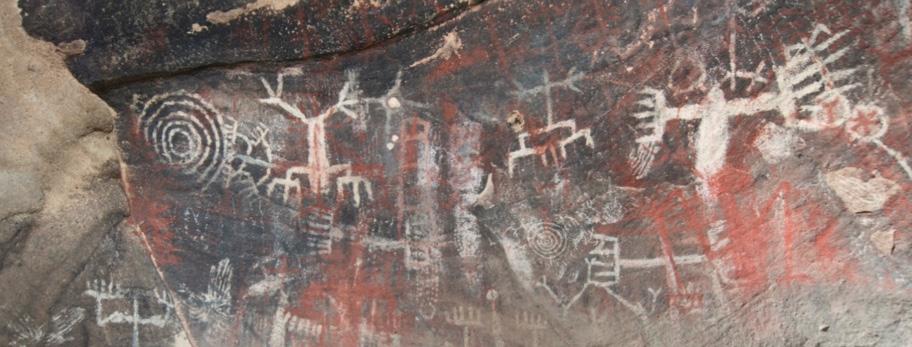NEWS
“Rarely black and white” Cultural Heritage Board recommends protection for contaminated site by Kimberly Rivers kimberly@vcreporter.com
Burro Flats Painted Cave. (Photo by D. Gandy)
A
2,850-acre site in the Santa Susana Mountains near Simi Valley that is sacred to at least four local Indigenous tribes is being considered for nomination to the National Register of Historic Places. Burro Flats is associated with the Chumash, Fernandeño, Kizh/Gabreileño and Tataviam Tribes. There are rock art sites — the best known being the Burro Flats Painted Cave, listed on the National Register of Historic Places in 1976 — as well as living sites, ceremonial locations and sacred areas. The land overlies the former site of the Santa Susana Field Lab, a location for rocket, nuclear and metals research starting in 1949 that left the land significantly contaminated. The site’s cleanup (or lack thereof) has been a point of fierce contention among local environmental groups, large corporations and government agencies since the 1970s, and some claim that the bid for cultural protection is an effort to sidestep remediation. Alan Salazar, a member of the elder’s council of the Fernandeño/ Tataviam Band of Mission Indians, says that when it comes to Indigenous issues, things are rarely “black and white.”
“A cultural sacred site”
“This was done at our request...that the site be designated as a cultural sacred site,” said Salazar. He was speaking to the VCReporter on the morning of Monday June 29, before the Ventura County Cultural Heritage Board would review and consider staff recommendation to support the nomination of the area to the National Register of Historic Places (NRHP) as Burro Flats Cultural District (BFCD).
The area is rich in culturally important elements, including rocks bearing pictographs, settings for winter and summer solstice celebrations and ceremonial locations where the ancestors of tribal members living here today gathered, sang and prayed. Salazar described “various hunting sites, places where someone was making points or arrowheads . . . called a ‘scatter.’” The 2,850acre swath borders the territories of three tribes. “You can walk a few miles west to Chumash territory, south to the Tongva lands and east to the Tataviam. We have had a relationship for thousands of years, traded, we intermarried, my family is Chumash and Tataviam,” Salazar explained. According to Salazar, cultural designation would not affect the required cleanup at all. He has worked as a monitor at the site for over six years, during the collection of soil samples and other activities, and said that most of the contamination is not in the areas near the most significant sites. “Where the most serious contamination is, is not anywhere close to the rock art site.”
Tribal involvement with cleanup efforts
These Indigenous sites are located on the former site of the Santa Susana Field Lab, which sustained chemical contamination from over 30,000 rocket fuel tests and a partial nuclear melt6—
— July 2, 2020
down in 1959. Soil and groundwater in the area is contaminated with carcinogenic materials including heavy metals and perchlorates and these toxic compounds have been found to migrate off the site during wind, rain and fire events. Initially covered up by the government, the contamination was made public by college students in the 1970s. For decades the public has demanded cleanup, but large corporations and government agencies actively evaded agreements that required full cleanup by 2017. Today, Boeing, the U.S. Department of Energy (DOE) and the National Aeronautics and Space Administration (NASA) are responsible for cleaning up the site, while the California Department of Toxic Substances Control (DTSC) is responsible for ensuring the cleanup occurs. The California Environmental Protection Agency (CalEPA) oversees the DTSC. To this day, no cleanup has begun. Recently, new agreements with the state set out a plan to begin removing buildings, but the public has little trust in the responsible parties and the plans are contingent on federal funding. Based on this history, many fear that the cultural district designation is merely one more opportunity for the responsible parties to evade their obligations. Salazar, however, said that, “This [cultural district] designation really has very little to do with the cleanup. What we will do is called mitigation [through] negotiation with all three [responsible parties]. We will negotiate the best way to clean it up.” Salazar estimates that only about five to 10 percent of the areas of archeological significance will require some kind of mitigation or cleanup activities. For the other 90 percent of the sites, “We will have monitors because they are close to other [important] sites . . . A majority of that is in the rock shelter on rock. That is not being removed.” In his opinion, there is no tension between those seeking to protect the archeological sites and those advocating for cleanup, but there are “disagreements on how much to clean up. In my opinion, the complexities of this site are related to [determining] how much you clean up and at what level...The highest level, that’s what the activists pound on their chest... If there is cleanup
at the highest level, that 2,800 acre site will look completely different. You’ll remove that much contaminated soil, removing almost all the vegetation, kill or remove dozens of ancient oak trees . . . you have to weigh that.” He’s spoken to radiation experts and said that removing all the top layers of soil, as some are calling for, may not be needed across large areas — and may in fact be harmful to the overall environment. “It’s going to destroy the natural, native plants, native animals. Mountain lions, the deer, all the native birds that live there. Many will be gone, no habitat, no brush . . . That site would look like the moon.” Salazar supports a “happy medium, not destroying all the plants and native animals, making it safe, but not destroying cultural sites.” “One thing I’ve come to realize after 40 years of involvement in Native American causes is that issues are very rarely black and white, there are always gray areas,” said Salazar. “In order for issues to be resolved it takes all the groups, that is six distinct groups.” He acknowledges there are disagreements along the way. “Have we asked for things that NASA has said no to? Yes. They had to give a little, we had to give a little. I hope that continues, stakeholders and local people need to sit down and work with all the different groups . . . It’s an extremely complex issue . . . That’s something that sometimes people don’t understand, how the negotiations between tribes and the government work.”
Cultural Heritage Board makes recommendation
The June 29 special meeting lasted over five hours, and resulted in a unanimous decision by the CHB to recognize that some areas inside the new boundaries proposed for the Burro Flats Cultural District (BFCD) meet the criteria for the site to be listed on the National Register of Historical Places (NRHP). During deliberations, however, board members questioned whether the site had integrity as a cultural site due to the contamination. In addition, many pondered whether a full cleanup needs to occur before nomination to the NRHP. Fifty-six written public comments were submitted, with over 20 people speaking at the online meeting. The strong majority asked the CHB to either deny the application for a cultural district, or recommend the process be delayed until the site is cleaned up due to a mistrust of NASA’s intentions. Some said it was an attempt to avoid doing proper cleanup. Salazar called the idea that NASA is trying to
evade a proper cleanup “completely false,” and said he has been working with NASA, Boeing and DOE representatives for 10 years, with members of several area tribes taking part in research on the site. “NASA takes seriously its role as a steward of the cultural resources within NASA-administered areas at SSFL and has been working with the Native American community to protect the irreplaceable cultural resources at SSFL,” said Matthew Rydin, press secretary for NASA, responding via email to the VCReporter on June 25. “The listing of the Burro Flats Cultural District as a Traditional Cultural Property in the National Register of Historic Places will not change or impact NASA’s commitment or responsibility to cleanup.” The CHB was careful to craft its recommendation to indicate that sites not yet identified within the district boundaries also be included in the cultural district, and that any protection afforded to the site which “impairs or impedes the legally mandated clean up efforts at the proposed district” would “conflict with public health, safety and general welfare.” Lan- Alan Salazar (Photo by Mona Lewis) guage was added to the recommendation that “legally mandated clean up efforts . . . include a remediation plan to protect the formally recognized resources during clean up activities.” The recommendations will now go to the Ventura County Board of Supervisors, (expected to be heard on July 28) who may add comments before transmitting the CHB recommendations to the California Office of Historic Preservation, which will review the comments and present recommendations to the State Historical Resources Commission on August 14, 2020.
117 sites of cultural significance
NASA applied to have the entire 2,850-acre area of SSFL be included on the national register, expanding the current 25-acre protected site encompassing the Burro Flats Painted Cave. That process compels the State Historical Resources Commission to seek input from local governments and cultural heritage commissions. Through collaborations with indigenous con-


